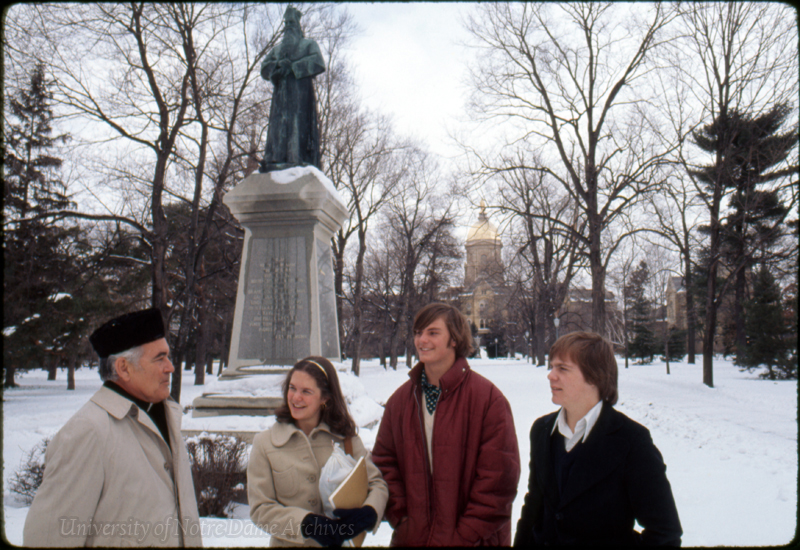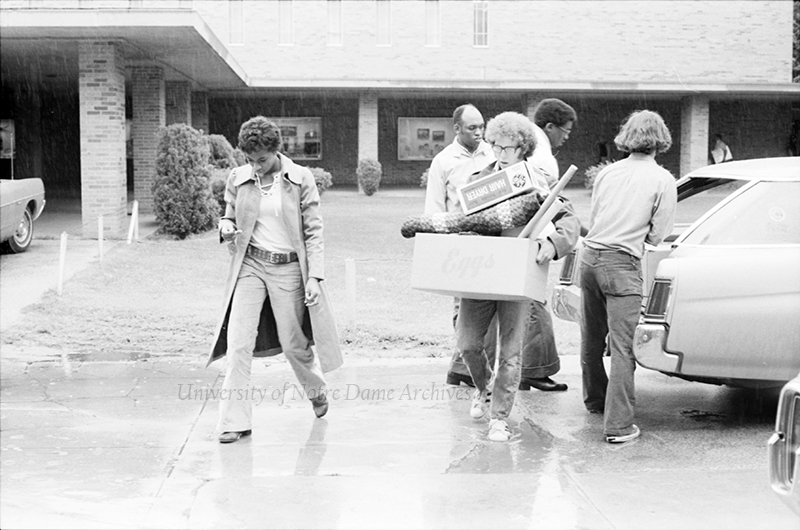 Caption
Caption
Source: University of Notre Dame Archives.
Coeducation: It's Official
Going Coed
The two schools would continue the co-exchange program, and Father Hesburgh would keep the door open to a future unification, but Saint Mary's College would continue as an all-women's college, and Notre Dame would prepare for coeducation, to begin in September of 1972.
In March 1972, an Advisory Committee for Coeducation was created to ease the upcoming transition. The men and women of the committee met to determine what steps were necessary to complete by the fall or in the near future. They also contacted schools, such as Yale and Princeton, which had recently become coeducational, to thoroughly study and consider what issues might arise.
The committee submitted their report with both short- and long-term goals. One of the first goals mentioned was the need to hire more women at all levels at the University. Not only would that be an important move in and of itself, but it would be vitally important for the new female students. Then the hall staff needed to be hired for Badin and Walsh as soon as possible in order to aid in the transition. The committee called for permanent general improvements to the dorms, but also temporary additions to the halls.
The committee encouraged the University to create a Center for Women. This Center would allow women an open space to discuss issues specific to them, to utilize the women at Notre Dame and Saint Mary's as resources, and to promote ongoing communication with the current campus community and incoming students.
In May 1972, in response to the coeducation committee report, Father Hesburgh offered his reflections in the Observer on the changes to come in the fall. He asked them to consider what coeducation would mean at Notre Dame, how they would change, and how the University would be transformed. He echoed the committee's report in his mention of the need for general "reflection, dialogue, discernment, and openness to change."
With just a few short months until the start of the fall semester, there was much to be accomplished on campus, most immediately, the transition of Walsh and Badin halls. For security, outdoor lights were installed, as well as a card-lock system in each hall, and women security guards were hired to staff the halls seven nights a week. The rooms were outfitted with curtains and full-length mirrors, and the basements were equipped with coin-operated washing machines and dryers, and an ironing room. Elsewhere on campus, a few changes were made as well. The infirmary was enlarged and divided, locker space was added at the Athletic and Convocation Center (or ACC-later renamed the Joyce Athletic and Convocation Center, or JACC), and the campus bookstore expanded its inventory.
The Women Arrive
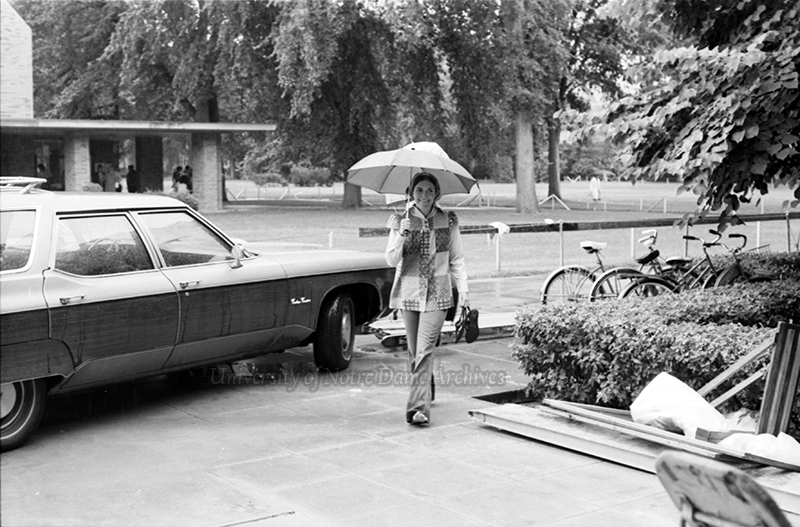
Source: University of Notre Dame Archives.
The first women arrived in early September-125 freshmen and 240 transfer students. The first year of coeducation, the ratio of male to female undergraduate students was 17:1. According to the assistant rector of Badin Hall at the time, Susan Bennett, "There were actually fewer women on campus the first year of coeducation than in prior years because the exchange program with Saint Mary's was cut back." It was that much more important to make the new students feel welcome at Notre Dame. A picnic and celebration were held on South Quad, and a banner hung from South Dining Hall that read, "We're Glad You're Here."
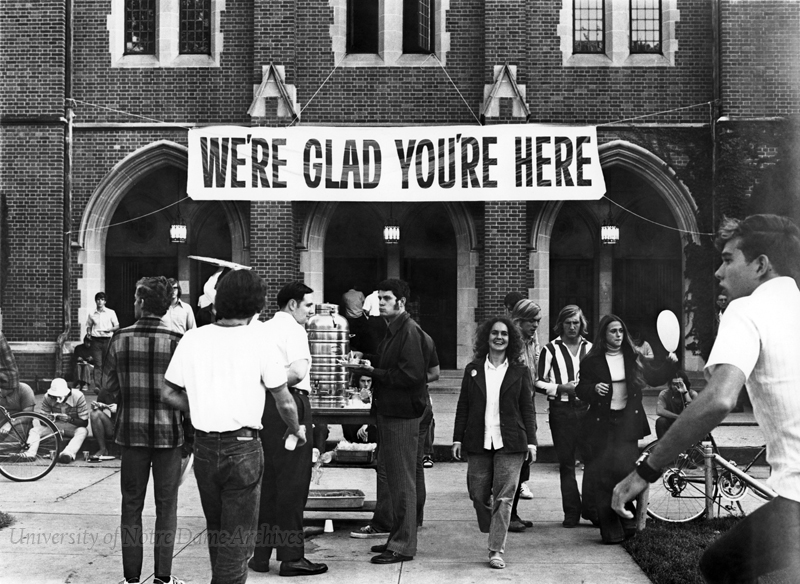
Source: University of Notre Dame Archives.

Source: University of Notre Dame Archives.
Many women in those early days, as chronicled in the book, Thanking Father Ted, remembered Father Hesburgh's comforting presence on campus. Susan Bennett, the first woman assistant rector of Badin Hall, recalled:
He kept a watchful eye on the integration process of the new women at ND. He seized every opportunity to reinforce the positive aspects of this culture change without patronizing the women or placating the men. He was truly a role model for his faculty and staff. He was a source of strength for those of us fighting the daily wars and/or supporting the young women students.
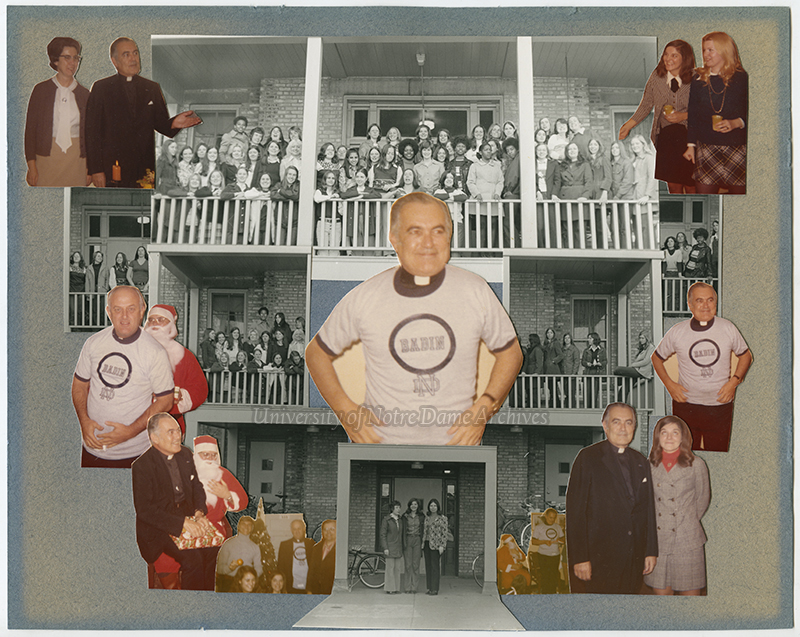
Source: University of Notre Dame Archives.
Kathleen Cekanski, the first woman rector of Badin Hall, remembered Father Hesburgh offering encouragement to the young women one evening:
He told us ... that walking down this new path was worth the fight. If we were going to make a positive impact on the university, we had to make a stand. We deserved to be here. Father's eloquence and presence meant a lot to each of the women that night.
Whether or not women had active social lives that first semester, they generally thrived in the classroom. The first class of undergraduate women at Notre Dame averaged a higher GPA than the men.
Many thought the first year was a success but that the transition was going too slowly; however, the administration agreed on a gradual transition to coeducation. Richard Conklin, Notre Dame's spokesperson during that time, later explained in Thanking Father Ted, "[t]his restriction [on female enrollment] was actually dictated by the university's single-sex residence hall policy, but it also served to phase in coeducation, which helped the transition."
Over the next few years, three more former men's dorms were converted to women's residences-Breen-Phillips, Farley, and Lyons. All the while, more and more men were moved to the remaining crowded men's halls or were forced to find housing off campus. As the number of religious women began to decline on campus, Lewis Hall was opened to laywomen in 1975. At this point, women made up about 20% of the student body. No more hall changes were made until 1981, when two new women's residence halls were added-Pasquerilla East and Pasquerilla West. Women then made up about 25 percent of the student body. After that, the numbers of women and new or converted residence halls would steadily increase.
A Better Place
In the interview Father Hesburgh gave for Thanking Father Ted in February 2007, he reflected, "Notre Dame is a much better place than it once was. It was always a great place. I think it was a great place because it was under the name and patronage of a woman. We couldn't have a better patroness or be named after a better person." He also said, "I think we are a much healthier place today. We are certainly a more intellectual place today. We are certainly a more cultural place today. And I have to say we are a better place today because about 50 percent of our students today are women."
Father Hesburgh concluded:
[T]o all of the daughters of Notre Dame, I would like to say I can't tell you how proud I am of the fact that you all bear Notre Dame degrees. By your lives and your goodness, you have changed the world in many ways. There is no telling how much more you can change the world. But, I can tell you how much the world needs changing. It is getting to be a pretty coarse, ugly kind of place. It needs the kind of refinement that only women can bring to human life. I have to thank you for the enormous loyalty you've shown to Notre Dame. It was no mistake to bring you into the family and to make you full-fledged members, half the population. You've given Notre Dame a whole new meaning in the life of women and marriage and family and education, business, and law.
List of Women's Firsts at Notre Dame
| Year | First |
|---|---|
| 1885 | First woman to be awarded the Laetare Medal: Eliza Allen Star |
| 1917 | First women to receive graduate degrees from Notre Dame: Sister Mary Frances Jerome (MA) and Sister Mary Lucretia (MS), both Sisters of the Holy Cross |
| 1918 | Notre Dame conferred its first honorary degree on a woman: Ellen Ryan Jolly |
| 1922 | First women to receive undergraduate degrees from Notre Dame: Sister Mary Aloysi Kiener (Sisters of Notre Dame, Cleveland, Ohio) Sister Margaret Mary (Sisters of Charity of St. Augustine, Lakewood, Ohio) Sister Mary Josephine (Ursuline Sisters of Brown County, Ohio) Sister Mary Veronique (Sisters of the Holy Cross, Notre Dame, Indiana) Antoinette Semortier (South Bend, Indiana) |
| 1932 | Graduate school officially open to women |
| 1965 | First female full-time faculty assistant professor in the general program:
Sister Suzanne Kelly, OSB First lay female professor (would also be the first woman to earn tenure): Dr. Josephine Massingberd Ford |
| 1966 | First woman principal commencement speaker: Barbara Ward |
| 1970 | First female Law School graduate: Grace Olivarez |
| 1971 | First female undergraduate admitted (of coed cohort): Mary Ann Proctor First female Vice President: Sister M. Alma Peter First female on Board of Trustees: Rosemary Parks |
| 1972 | First woman to receive a bachelor's degree in Business Administration: Mary Eileen Davey |
| 1973 | First female graduating class (of coed cohort) First female dean of the College of Arts and Letters: Sister Isabel Charles |
| 1974 | First female valedictorian: Marianne O'Connor |
| 1975 | First female editor of the Dome: Susan Darin |
| 1976 | First woman chair of a capital campaign: Ernestine Morris Carmichael Raclin First women's varsity sports: Fencing and Tennis First female monogram winners: Mary Behler (tennis) Catherine Buzard (fencing) Jane Lammers (tennis) Christina Marciniak (fencing) Kathleen Valdiserri (fencing) |
| 1977 | First female editor of the Observer: Martha Hogan (SMC) |
| 1980 | First female Marching Band drum major: Linda Batista (SMC) |
| 1981 | First ND female Marching Band drum major: Toni Faini |
| 2001 | First female student body president: Brooke Norton |
| 2005 | First female president of the Notre Dame Monogram Club: Julie Pierson Doyle |
| 2006 | First Irish guardswoman, Molly Kinder |
